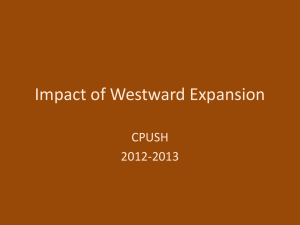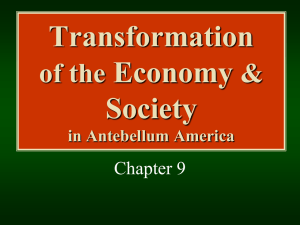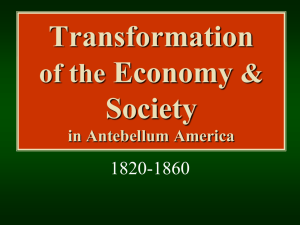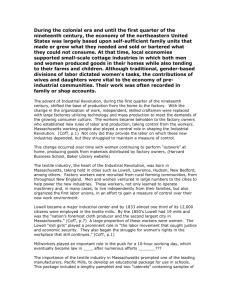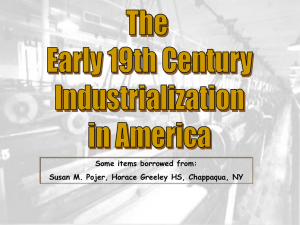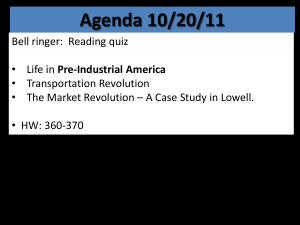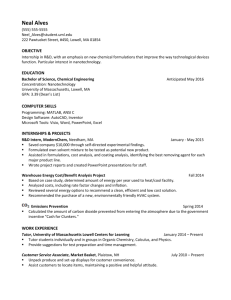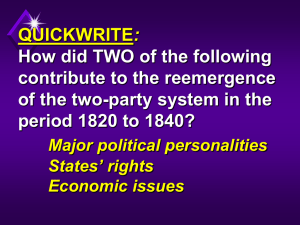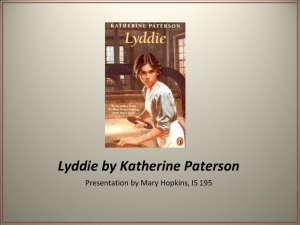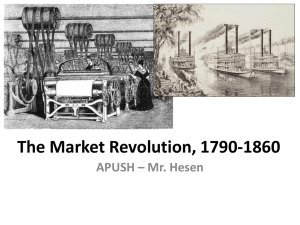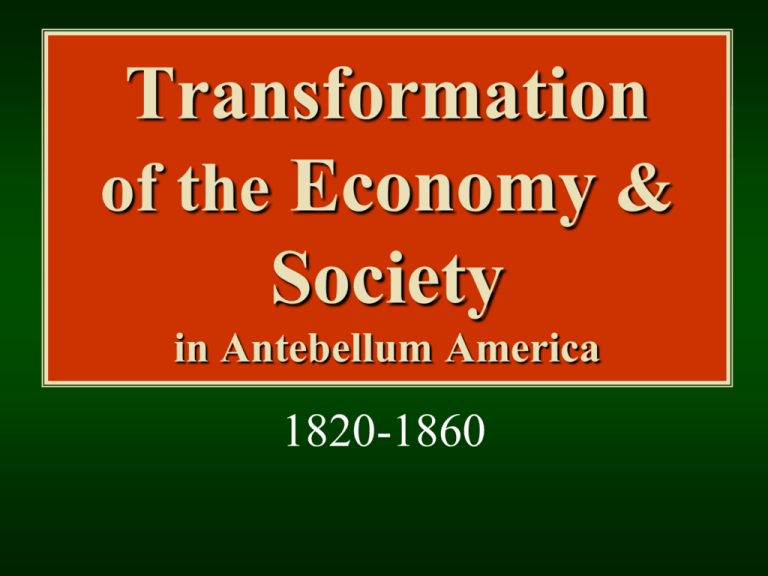
Transformation
of the Economy &
Society
in Antebellum America
1820-1860
THE TRANSPORTATION REVOLUTION &
CREATION OF A NATIONAL MARKET ECONOMY
agrarian economy
Market Revolution
Key catalysts:
(1) transportation improvements – canals, RRs
(2) development of textile mills and factories
(3) innovations in banking and legal practices
(4) Capital – from Europe (esp. Britain)
(5) Population growth – 9M in 1820 → 30+M in 1860
Not Yet the Industrial Revolution
TRANSPORTATION REVOLUTION
turnpikes
National Road
TRANSPORTATION REVOLUTION
Steamboats
– Robert Fulton
– Clermont (1807)
Impact on
transportation and
trade
Robert Fulton’s Clermont plies the
Hudson River
TRANSPORTATION REVOLUTION
Erie Canal (1825)
Significance
– Cost of trade
– Direction of trade
– Settlement of NW
– New York City
– Upstate NY
– Canal boom
TRANSPORTATION REVOLUTION
Principal Canals in 1840
Roads and Canals, 1820-1850
• Canal boom
• Effect on transportation and
trade patterns
Paths of Northern Migration after 1800
TRANSPORTATION REVOLUTION
Railroads
Baltimore &
Ohio RR (1830)
short lines
trunk lines
Mohawk And Hudson Railroad’s Dewitt Clinton
National
Market
Economy:
Inland
Freight Rates,
1790-1865
National Market
Economy:
The Speed of
News in 1817
and 1841
BEGINNINGS OF
INDUSTRIALIZATION
Factory System
Rise of Corporations
Technological Innovations
Labor
Old Northwest
BEGINNINGS OF INDUSTRIALIZATION
textiles
Samuel Slater
factory system
Samuel Slater
(“Father of the
Factory System”)
BEGINNINGS OF INDUSTRIALIZATION
Lowell (or Waltham) Factory System
– Francis Cabot Lowell
– First dual-purpose textile plants
– employees
Lowell towns
Lowell, Mass. in 1850
New England Textile
Centers: 1830s
Middlesex Company Woolen Mills, Lowell, Massachusetts, c. 1848, artist unknown
Middlesex Company Woolen Mills, Lowell, Massachusetts, c. 1848, artist unknown
Copyright © Houghton Mifflin Company. All rights reserved.
Lowell Girls
Lowell Girls
Early
Textile
Loom
• Lowell Girls - typical “profile”
• Factory Girls Association
Lowell Boarding Houses
BEGINNINGS OF INDUSTRIALIZATION:
Legal and Financial Developments
Corporations
– In 1800, c. 20 corps US; by 1817, over 1800
– General incorporation laws
• New York, 1848
– stock
– limited liability
Banking – paper banknotes
Eli Whitney: The
Cotton Gin, 1791
(Actually invented
by a slave)
Eli Whitney’s Gun Factory
Interchangeable Parts Rifle
John Deere & the Steel Plow
Cyrus McCormick
& the Mechanical Reaper
Samuel F. B. Morse
1840 – Telegraph
Cyrus Field
& the Transatlantic Cable, 1858
Elias Howe & Isaac Singer
1840s
Sewing Machine
3. LABOR & THE EARLY UNION
MOVEMENT
craft societies
National Trades’ Union
Early issues:
– Child Labor Laws
– 10 Hour Workday
– Right to Strike
Commonwealth v. Hunt (Massachusetts,1842)
Early unions were usually local, social, and weak
– and were largely ineffective before the Civil War
CHANGES TO SOCIETY
The market economy changed:
class structure
The nature and location of work
Gender roles (Middle class)
the standard of living
Social Class structure
Working class
Rise of the middle class
Social mobility?
Geographic mobility
UPPER
MIDDLE
WORKING
LOWER
Where do Farmers fit?
CHANGES TO
SOCIETY
Work & Home
Lower birthrates
“Separate Spheres”
– end of cottage industry
– new gender roles
“cult of domesticity”
employment opportunities
Education of women
– Oberlin College
Occupations of Women Wage
Earners in Massachusetts, 1837
POPULATION GROWTH
1775
1790
1820
1840
1860
2.5 Million
4 Million
10 Million
17 Million
32 Million
Immigration
Major immigrant groups
Irish
Germans
English
When did they come?
Where did they settle?
National Origin
of Immigrants:
1820 - 1860
Immigration
to the United
States, 18201860
The distribution of foreign-born residents of the
United States in 1860.

